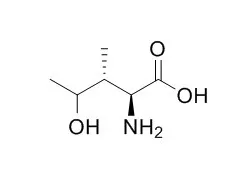| Description: |
4-Hydroxyisoleucine has antidepressant-like, antidyslipidemic, and antihyperglycemic effects. It acts to improve insulin resistance by promoting mitochondrial biogenesis in high fructose diet fed STZ induced diabetic rats, it also has beneficial effects on low-grade inflammation. |
| Targets: |
TNF-α | AMPK | Akt | GSK-3 | ROS | NF-kB | JNK | ERK | p38MAPK | 5-HT Receptor |
| In vitro: |
| Mol Cell Endocrinol. 2014 Sep;395(1-2):51-60. | | 4-Hydroxyisoleucine ameliorates fatty acid-induced insulin resistance and inflammatory response in skeletal muscle cells.[Pubmed: 25109277] | The 4-Hydroxyisoleucine (4-HIL), an unusual amino acid isolated from the seeds of Trigonella foenum-graecum was investigated for its metabolic effects to ameliorate free fatty acid-induced insulin resistance in skeletal muscle cells.
METHODS AND RESULTS:
An incubation of L6 myotubes with palmitate inhibited insulin stimulated-glucose uptake and -translocation of glucose transporter 4 (GLUT4) to the cell surface. Addition of 4-Hydroxyisoleucine strongly prevented this inhibition. We then examined the insulin signaling pathway, where 4-Hydroxyisoleucine effectively inhibited the ability of palmitate to reduce insulin-stimulated phosphorylation of insulin receptor substrate-1 (IRS-1), protein kinase B (PKB/AKT), AKT substrate of 160 kD (AS160) and glycogen synthase kinase 3β (GSK-3β) in L6 myotubes. Moreover, 4-Hydroxyisoleucine presented strong inhibition on palmitate-induced production of reactive oxygen species (ROS) and associated inflammation, as the activation of NF-κB, JNK1/2, ERK1/2 and p38 MAPK was greatly reduced. 4-Hydroxyisoleucine also inhibited inflammation-stimulated IRS-1 serine phosphorylation and restored insulin-stimulated IRS-1 tyrosine phosphorylation in the presence of palmitate, leading to enhanced insulin sensitivity.
CONCLUSIONS:
These findings suggested that 4-Hydroxyisoleucine could inhibit palmitate-induced, ROS-associated inflammation and restored insulin sensitivity through regulating IRS-1 function. |
|
| In vivo: |
| Fitoterapia. 2014 Dec;99:307-17. | | 4-Hydroxyisoleucine improves insulin resistance by promoting mitochondrial biogenesis and act through AMPK and Akt dependent pathway.[Pubmed: 25454462] | 4-Hydroxyisoleucine (4-HIL) is an unusual amino acid isolated from fenugreek seeds (Trigonella foenum graecum L). Various studies have shown that it acts as an antidiabetic agent yet its mechanism of action is not clear.
METHODS AND RESULTS:
We therefore investigated the effect 4-Hydroxyisoleucine on the high fructose diet fed streptozotocin induced diabetic rats and L6 myotubes. 4-Hydroxyisoleucine (50 mg/kg) has improved blood lipid profile, glucose tolerance and insulin sensitivity in a diabetic rat model. It has increased the glucose uptake in L6 myotubes in AMPK-dependent manner and upregulated the expression of genes (PGC-1α, PGC-1β, CPT 1 and CPT 2), which have role in mitochondrial biogenesis and energy metabolism in the liver, skeletal muscles as well as in L6 myotubes. Interestingly, it also increased the AMPK and Akt expression along with their phosphorylated forms in the liver and muscle tissues of treated animals.
CONCLUSIONS:
Altogether we concluded that 4-Hydroxyisoleucine acts to improve insulin resistance by promoting mitochondrial biogenesis in high fructose diet fed STZ induced diabetic rats. | | Bioorg Med Chem Lett. 2006 Jan 15;16(2):293-6. | | 4-hydroxyisoleucine an unusual amino acid as antidyslipidemic and antihyperglycemic agent.[Pubmed: 16246556 ] | Trigonella foenum-graecum, commonly known as fenugreek, is an annual herbaceous plant.
METHODS AND RESULTS:
From the seeds of T. foenum-graecum an unusual amino acid, 4-Hydroxyisoleucine 5, has been isolated, which significantly decreased the plasma triglyceride levels by 33% (P<0.002), total cholesterol (TC) by 22% (P<0.02), and free fatty acids by 14%, accompanied by an increase in HDL-C/TC ratio by 39% in the dyslipidemic hamster model. |
|






 Cell. 2018 Jan 11;172(1-2):249-261.e12. doi: 10.1016/j.cell.2017.12.019.IF=36.216(2019)
Cell. 2018 Jan 11;172(1-2):249-261.e12. doi: 10.1016/j.cell.2017.12.019.IF=36.216(2019) Cell Metab. 2020 Mar 3;31(3):534-548.e5. doi: 10.1016/j.cmet.2020.01.002.IF=22.415(2019)
Cell Metab. 2020 Mar 3;31(3):534-548.e5. doi: 10.1016/j.cmet.2020.01.002.IF=22.415(2019) Mol Cell. 2017 Nov 16;68(4):673-685.e6. doi: 10.1016/j.molcel.2017.10.022.IF=14.548(2019)
Mol Cell. 2017 Nov 16;68(4):673-685.e6. doi: 10.1016/j.molcel.2017.10.022.IF=14.548(2019)